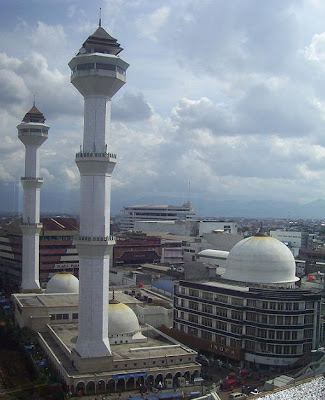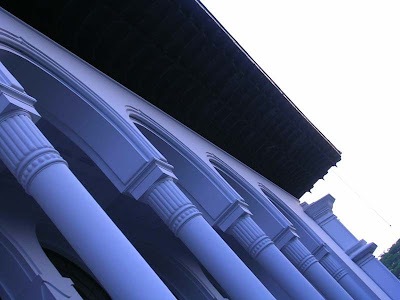Paris Van Java Mall
(PVJ)

If you like shopping, when you visit Bandung, don’t forget to go to Paris Van Java Mall, this place as a must for visitors. Bandung is a city that is very popular with shopping and culinary knowledge. Paris Van Java Mall is one of the entertainment center in the Bandung which is located in Jl. Sukajadi. The location is easy to be reached, close to the Setiabudi Road, also near the Pasir Kaliki road, and also very close to the Cihampelas Walk that is very hot at the moment.
Look at Paris Van Java Mall, from the outside only represents what is quite an impression that would be submitted to all the visitors who come. Very cozy, spacious and roomy, with a full feel of modern environment-friendly. If you come in the evening, you’ll see the atmosphere and glorious eye catching offered with its many lights placed in the trees in the mall parking lot is also very large. Entering the park, and how knowledgeable no need to worry because parking place can be sure that you can park your car. There you can go for window shopping or lunch in nice cafes with your friends or family who might be invited.

Well, now we talk about the mall, I am very impressed to the management of Paris Van Java Mall in such a way this has all sett the layout counter in the front of this mall. From edge to edge and filled with stalls filled with food, meal, Snacks, beverages, coffee, etc.. Call only outlets that we know are familiar, Starbucks Coffee, Black Canyon Coffee, J. Co Donuts, Oh La La Cafe, Manchester United Cafe & Bar, and a restaurant that offers a variety of concepts of each. Ethnic traditional Indonesia there, the cuisine a la carte there be like a westerner, a Japanese cuisine. Really complete.
Go to inside, there you can shopping fashion clothes or just simply want to window shopping. There are various fashion outlets and apparels on the floor and a basement. All outlets have a majority is branded outlets. A course Esprit, Mango, Giordano, Hammer, not to mention the outlet of the bag and shoes make me dizzy spell to read one by one. Down there on the floor Gramedia, where there is a spa and salon is also one I do not remember. There are also outlets health and beauty clinic, and so many more. Also have lingerie boutiques also do not want to lose consecutive enliven Paris Van Java Mall this. So wonderful!.
Well if you have more time, you can go to Carrefour. It’s a huge department store, this mall is a joint venture with SOGO, a shopping center that is known to middle-class and above. If you like to go to Cinema to see newest movie, you can go to Blitz Megaplex. There are more than 10 cinemas in a theater, so you can choose the your favorite movie in this wonderful cinema. There is also a lounge where you can sit and talk with your partner while you wait for the movie. There is billyard place if you like to do sport near to the Cinema. That essentially, It’s not expensive to watch movie at the Blitz Megaplex, you will will not make you regret, If you only have 50,000 rupiah in the wallet it’s more than enough. The Sound system is so fantastic, I think it’s the best cinema in Bandung.
So that, If you never visit to Paris Van Java Mall, I recommended you to visit there, I believe that you won’t regret it. Have fun!
 Map to Paris Van Java Mall
Map to Paris Van Java Mall
Look at Paris Van Java Mall, from the outside only represents what is quite an impression that would be submitted to all the visitors who come. Very cozy, spacious and roomy, with a full feel of modern environment-friendly. If you come in the evening, you’ll see the atmosphere and glorious eye catching offered with its many lights placed in the trees in the mall parking lot is also very large. Entering the park, and how knowledgeable no need to worry because parking place can be sure that you can park your car. There you can go for window shopping or lunch in nice cafes with your friends or family who might be invited.

Well, now we talk about the mall, I am very impressed to the management of Paris Van Java Mall in such a way this has all sett the layout counter in the front of this mall. From edge to edge and filled with stalls filled with food, meal, Snacks, beverages, coffee, etc.. Call only outlets that we know are familiar, Starbucks Coffee, Black Canyon Coffee, J. Co Donuts, Oh La La Cafe, Manchester United Cafe & Bar, and a restaurant that offers a variety of concepts of each. Ethnic traditional Indonesia there, the cuisine a la carte there be like a westerner, a Japanese cuisine. Really complete.
Go to inside, there you can shopping fashion clothes or just simply want to window shopping. There are various fashion outlets and apparels on the floor and a basement. All outlets have a majority is branded outlets. A course Esprit, Mango, Giordano, Hammer, not to mention the outlet of the bag and shoes make me dizzy spell to read one by one. Down there on the floor Gramedia, where there is a spa and salon is also one I do not remember. There are also outlets health and beauty clinic, and so many more. Also have lingerie boutiques also do not want to lose consecutive enliven Paris Van Java Mall this. So wonderful!.
Well if you have more time, you can go to Carrefour. It’s a huge department store, this mall is a joint venture with SOGO, a shopping center that is known to middle-class and above. If you like to go to Cinema to see newest movie, you can go to Blitz Megaplex. There are more than 10 cinemas in a theater, so you can choose the your favorite movie in this wonderful cinema. There is also a lounge where you can sit and talk with your partner while you wait for the movie. There is billyard place if you like to do sport near to the Cinema. That essentially, It’s not expensive to watch movie at the Blitz Megaplex, you will will not make you regret, If you only have 50,000 rupiah in the wallet it’s more than enough. The Sound system is so fantastic, I think it’s the best cinema in Bandung.
So that, If you never visit to Paris Van Java Mall, I recommended you to visit there, I believe that you won’t regret it. Have fun!
 Map to Paris Van Java Mall
Map to Paris Van Java Mall





 14:24
14:24
 kaniamazdar
kaniamazdar

 Bandung City Square (Alun-alun)
Bandung City Square (Alun-alun)
 Mesjid Agung Bandung
Mesjid Agung Bandung Shopping Center
Shopping Center



 Map of Bandung
Map of Bandung












